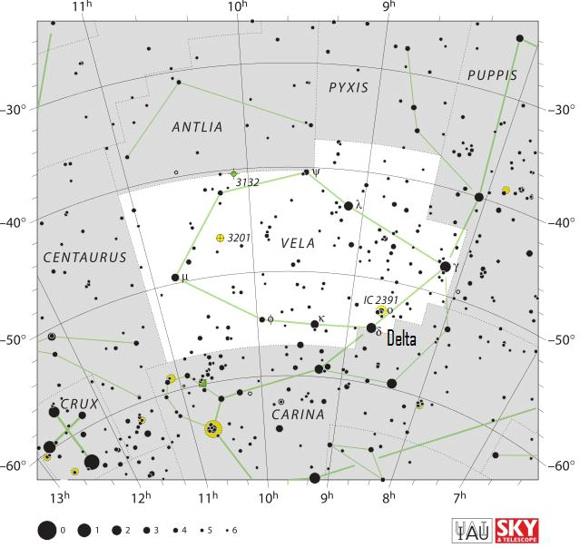
Tonight, as darkness falls, use Orion’s Belt to star-hop to Sirius, a future South Pole Star. Sirius is in the constellation Canis Major, the Greater Dog. It’s sometimes called the Dog Star. It’s easy to see, since it’s the brightest star in the night sky. You’ll always know you’ve found Sirius if you notice that the three stars in Orion’s Belt point to it.
Here in the Northern Hemisphere, we’re lucky to have a moderately bright star, Polaris, to pinpoint our north celestial pole. If you know Polaris, and get lost, this star can help you to regain your bearings.
Unlike the Northern Hemisphere, the Southern Hemisphere doesn’t have a bright pole star. There just doesn’t happen to be a bright star, not even a moderately bright star like Polaris, to mark the south celestial pole, the point in the sky directly over the Earth’s South Pole.
But the stars are not truly fixed. Because stars actually change positions relative to one another over the long course of time, brilliant Sirius will take its turn as the South Pole Star in the year 66270. In fact, Sirius will come to within 1.6 degrees of the south celestial pole in 66270. One precessional cycle later, in the year 93830, Sirius will miss aligning with the south celestial pole by only 2.3 degrees.
The star Polaris comes closer to the north celestial pole, by the way. It’ll be within 0.5 degrees of the north celestial pole in the year 2100.
What’s more, before Sirius becomes a pole star, another star – a moderately bright star, not very different in brightness from Polaris – will take its place more or less over the south celestial pole. That’ll happen about 7,000 years from now. Because of precession, the star Delta Velorum in the constellation Vela the Sail will come to within 0.2 degrees of the south celestial pole in the year 9250. That’s closer to marking the celestial pole than Polaris or Sirius ever do during their reigns as the pole star!
By the way, for reference, the moon’s angular diameter spans 0.5 degrees of sky.
Source: Mathematical Astronomy Morsels V by Jean Meeus, pages 353 to 363

View larger. The constellation Vela the Sail
Bottom line: Nighttime’s brightest star, Sirius aka the Dog Star, will come to within 1.6 degrees of the south celestial pole in the year 66270.
from EarthSky http://bit.ly/2SZT0Uk

Tonight, as darkness falls, use Orion’s Belt to star-hop to Sirius, a future South Pole Star. Sirius is in the constellation Canis Major, the Greater Dog. It’s sometimes called the Dog Star. It’s easy to see, since it’s the brightest star in the night sky. You’ll always know you’ve found Sirius if you notice that the three stars in Orion’s Belt point to it.
Here in the Northern Hemisphere, we’re lucky to have a moderately bright star, Polaris, to pinpoint our north celestial pole. If you know Polaris, and get lost, this star can help you to regain your bearings.
Unlike the Northern Hemisphere, the Southern Hemisphere doesn’t have a bright pole star. There just doesn’t happen to be a bright star, not even a moderately bright star like Polaris, to mark the south celestial pole, the point in the sky directly over the Earth’s South Pole.
But the stars are not truly fixed. Because stars actually change positions relative to one another over the long course of time, brilliant Sirius will take its turn as the South Pole Star in the year 66270. In fact, Sirius will come to within 1.6 degrees of the south celestial pole in 66270. One precessional cycle later, in the year 93830, Sirius will miss aligning with the south celestial pole by only 2.3 degrees.
The star Polaris comes closer to the north celestial pole, by the way. It’ll be within 0.5 degrees of the north celestial pole in the year 2100.
What’s more, before Sirius becomes a pole star, another star – a moderately bright star, not very different in brightness from Polaris – will take its place more or less over the south celestial pole. That’ll happen about 7,000 years from now. Because of precession, the star Delta Velorum in the constellation Vela the Sail will come to within 0.2 degrees of the south celestial pole in the year 9250. That’s closer to marking the celestial pole than Polaris or Sirius ever do during their reigns as the pole star!
By the way, for reference, the moon’s angular diameter spans 0.5 degrees of sky.
Source: Mathematical Astronomy Morsels V by Jean Meeus, pages 353 to 363

View larger. The constellation Vela the Sail
Bottom line: Nighttime’s brightest star, Sirius aka the Dog Star, will come to within 1.6 degrees of the south celestial pole in the year 66270.
from EarthSky http://bit.ly/2SZT0Uk

Aucun commentaire:
Enregistrer un commentaire